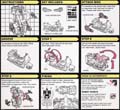As the Transformers brand reached its peak in 1986 Hasbro unleashed a gamut of new toys and merchandise. However, they had nearly exhausted Takara’s former Diaclone designs, and thus turned to unfinished ideas for that series. Most of these new designs were Combiners, which had proved wildly popular with 1985’s Devastator. One of these new combiners was Groove, a white Harley-Davidson FLH Electra Glide 1340 (with a front faring resembling a 1983 Honda GoldWing).
Origins
Groove was originally conceptualized for a Diaclone subseries called “Jizai Gattai”, or Free Combination, which would have included the Stunticons, Combaticons, Aerialbots, Protectobots, and Metroplex. Each team had a theme, each limb figure could combine with any other team leader as any limb, and each leader figure had some sort of base mode, usually, with a spring-loaded vehicle launcher. All the figures could also interact with Metroplex. However, Transformers’ imminent success put Diaclone and Jizai Gattai on ice. It was Transformers’ long term success that saw these designs to completion, however. Groove was designed by Kaoru Matsumoto. His US Patent, titled Reconfigurable toy autobike (aka Transformers G1 Groove) was filed on October 24, 1985 (U.S. Patent No. USD296801 S).
Description
Groove transforms into a modified Harley-Davidson FLH Electra Glide police motorcycle. He features a fair deal of molded realistic detail, despite the Honda Goldwing front fairing, twin molded headlights, and windshield. He features accurately molded V-Twin engine on the asymmetrical chromed sides of the motorcycle, as well as detailed molding of the distinctive front fender and saddle bags. Police stickers decorate his gas tank, but he lacks any semblance of police lights or equipment. He features two large rolling wheels, as well as small nubs under his exhaust pipes that help the motorcycle to balance upright. He can transform into an “Attack Bike” by attaching his two large cannons to the pegs on his trunk. His transformation is very simple, but somewhat unusual. The seat splits and rotates to the back of the bike to form his feet, while the chrome engine panels slide down to form the robot's arms. Finally, the front fork is rotated around to the top of the bike, and the robot's head is tilted forward. The robot mode is scantly decorated, and only distinguished from the bottom of the motorcycle by the molded chestplate. He can wield his large cannons on the sides of his legs, and his pistol by a horzontal peg that plugs into a sideways hole through the end of his arm. As a “Scramble City” combiner, Groove can transform into any combiner’s leg or arm by flipping front wheel back, or flipping the head down toward the chest, respectively, and attaching the appropriate accessory. He typically forms Defensor’s right leg.
Collector Notes
Take care when removing Groove, or any other combiner limb, from a leader figure’s socket.
Variants
Groove has several production variations over the course of G1. Early 1986 figures had a gold-colored die-cast metal chest, while later 1986 and 1987 production used an unpainted silver plastic chest. A third variant exists from 1991 that does not have a rubsign on the windshield, but the indent was not filled in.
Availability
Groove was available individually carded or in a Defensor gift set in 1986. Due to the popularity of combiners, he was available again in 1987, packaged with or without a random Autobot Decoy. He was available in 1991 in Europe’s continuation of G1, without a rubsign.
Redecos & Retools
Groove’ mold was used again in 1992 to make Operation Combination Sparkride, available only in the Guard City gift set. Groove was slated to be released in G2, neon orange and teal. Though the G2 Protectobots were cancelled, a handful of samples exist, including some sealed examples.

















